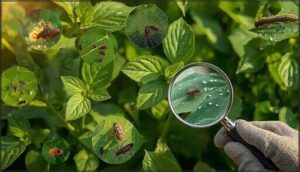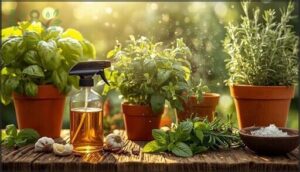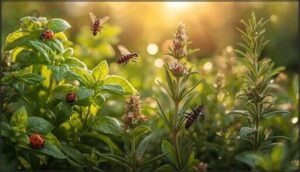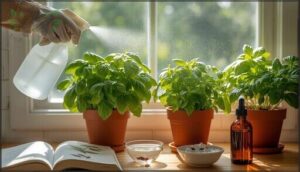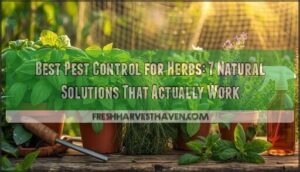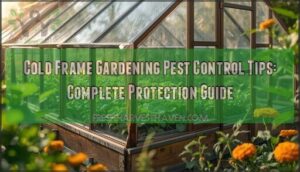This site is supported by our readers. We may earn a commission, at no cost to you, if you purchase through links.
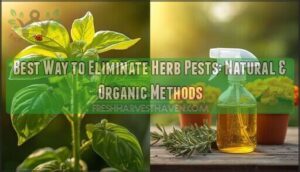 Your basil looked perfect yesterday. This morning, tiny green aphids coat the undersides of every leaf—and they’re multiplying. These soft-bodied pests can double their population in less than a week, turning healthy herb gardens into feeding grounds before you notice the damage. Spider mites, whiteflies, caterpillars, slugs, and snails work just as quickly, each species exploiting different vulnerabilities in your plants.
Your basil looked perfect yesterday. This morning, tiny green aphids coat the undersides of every leaf—and they’re multiplying. These soft-bodied pests can double their population in less than a week, turning healthy herb gardens into feeding grounds before you notice the damage. Spider mites, whiteflies, caterpillars, slugs, and snails work just as quickly, each species exploiting different vulnerabilities in your plants.
The best way to eliminate herb pests combines prevention with targeted action: companion planting cuts infestations by over 40 percent, while organic treatments like neem oil and insecticidal soap achieve 75–93 percent mortality rates without harming beneficial insects. Understanding which pests you’re facing and how to deploy natural defenses protects your harvest without chemical residues.
Table Of Contents
- Key Takeaways
- Identifying Common Herb Pests
- Preventing Herb Pests Naturally
- Organic and Natural Pest Control Methods
- Employing Beneficial Insects for Pest Control
- Safe Use of Insecticides and Alternatives
- Frequently Asked Questions (FAQs)
- How do I get rid of bugs in my herb garden?
- Do herbs have bugs?
- How do I get rid of pests in my garden?
- How do I get rid of ladybugs in my herb garden?
- How do I Keep my herbs healthy?
- Do aphids eat herbs?
- How often should I inspect herbs for pests?
- Can pests develop resistance to natural treatments?
- What time of day works best for spraying?
- How do I store homemade pest control sprays?
- Conclusion
Key Takeaways
- Combining companion planting with organic treatments delivers the strongest defense—companion plants reduce infestations by 40%, while neem oil and insecticidal soap achieve 75–93% pest mortality without harming beneficial insects.
- Early detection through twice-weekly inspections prevents exponential pest growth, since aphids can double their population in under a week and caterpillars can strip 20–40% of foliage within days.
- Healthy soil creates natural pest resistance by supporting beneficial microbes and proper nutrient balance—adding organic matter increases beneficial nematodes by 40% and reduces fungus gnat outbreaks by 45%.
- Layering multiple natural defenses (beneficial insects, physical barriers, organic sprays) creates long-term resilience that chemical pesticides can’t match, cutting chemical use by 50–70% while maintaining plant health.
Identifying Common Herb Pests
Before you can tackle pests, you need to know what you’re dealing with. Different insects leave distinct clues on your herbs, from clustered colonies to telltale webbing.
Here’s how to spot the most common culprits damaging your plants.
Aphids, Spider Mites, and Whiteflies
These three sap-sucking pests attack your herbs differently but cause similar damage. Aphids cluster on basil and mint leaves, doubling their numbers in under a week. Spider mites web across dill and cilantro, with females laying up to 100 eggs each. Whiteflies flutter around plants leaving sticky residue, but companion planting with marigolds cuts infestations by over 40 percent.
Effective pest control methods can help mitigate the damage caused by these pests.
Caterpillars, Slugs, and Snails
While sap-suckers drain your plants, larger pests chew them to pieces. Caterpillars like cabbage loopers can strip 20–40% of parsley and fennel foliage in days. Slugs and snails thrive when humidity tops 80%, and you’ll find them demolishing young basil overnight.
Copper barriers and organic baits reduce slug access by over 80%, while beer traps catch up to 60% of active snails. Regular pest monitoring lets you spot caterpillar control needs early and apply natural pest control before damage escalates. Effective slug control methods can help prevent significant damage to plants.
Signs of Pest Damage on Herbs
Spotting pest damage early makes all the difference. Watch for yellowing or curling leaves—aphid infestations drop chlorophyll by 30%, slowing photosynthesis. Check for irregular holes from caterpillars or ragged edges from slugs. Herb wilting signals sap-suckers draining nutrients, while sticky honeydew points to whiteflies. Fine webbing means spider mites.
These pest damage descriptions help you identify garden pests fast and start pest control before fungal diseases take hold or plant stress becomes irreversible.
Preventing Herb Pests Naturally
The best defense against herb pests starts before they ever arrive. You can create conditions that naturally discourage infestations through smart planting choices, soil care, and simple preventive habits.
Let’s look at three practical strategies that keep your herbs thriving without reaching for pesticides.
Companion Planting Strategies
You can turn your herb garden into a fortress by pairing plants strategically. Companion planting for pest control uses plant diversity to create natural defenses—marigolds deter nematodes by up to 90%, while basil intercropped with herbs reduces whitefly populations markedly.
Trap crops like nasturtiums divert pests away, decreasing damage by 50%. This polyculture approach attracts beneficial insects and builds biodiversity, making your garden more resilient while supporting soil health naturally.
Maintaining Healthy Soil and Plants
Your soil is the foundation of natural pest control—when it’s thriving, your herbs can fend off invaders with ease. Soil health directly impacts plant resilience, so focus on these key practices:
- Improve Soil Aeration: Incorporate 4 inches of organic matter to boost porosity and discourage pest larvae in compacted zones.
- Balance Nutrients: Avoid excess nitrogen, which can increase aphid populations by 30–50%, and secure adequate potassium for stronger plant defenses.
- Support Microbial Balance: Add compost to increase beneficial nematodes by 40%, enhancing root development and natural pest suppression.
- Adjust Moisture: Use deep, infrequent watering to build resilient roots and reduce fungus gnat outbreaks by up to 45%.
Healthy soil drives nutrient cycling and creates an ecosystem where beneficial insects and microbes work together, keeping your organic gardening efforts on track.
Physical Barriers and Garden Hygiene
Exclusion nets and row covers stop pests before they reach your herbs—trials show nets cut pest damage by 80%, while row covers blocked 100% of squash bugs.
Pair barrier methods like copper barriers and mulch application with daily garden sanitation, and you’ll see up to 85% fewer pest outbreaks.
Remove debris promptly and clean tools regularly—this combo lowers infestations by 60% while supporting manual removal efforts when needed.
Organic and Natural Pest Control Methods
When pests show up on your herbs, you don’t need harsh chemicals to solve the problem. Natural pest control methods work effectively while keeping your plants safe to eat.
Here’s how to protect your herb garden using organic solutions that target pests without compromising your harvest.
Using Diatomaceous Earth
Diatomaceous earth works like a microscopic barrier, cutting through soft pest bodies and causing dehydration within 48 hours. This food-grade powder contains 80–90% silica that kills mechanically, not chemically—making it a safe organic insecticide and soil treatment option.
You’ll see the best results when you apply it properly:
- Dust the soil base and leaf undersides in dry weather for maximum contact
- Reapply every 7–10 days since moisture greatly reduces effectiveness
- Combine with beneficial insects for up to 60% better pest control
DE achieves 85% control against aphids and whiteflies when used consistently as a natural repellent and pest barrier.
Homemade Garlic and Essential Oil Sprays
Garlic spray acts as your frontline defense, repelling aphids and mites with sulfur compounds that disrupt feeding cycles.
You can boost effectiveness by blending garlic with essential oils—rosemary or oregano work best, achieving up to 80% pest mortality in 24 hours.
Mix one crushed garlic head per quart of water, steep 12 hours, then add a tablespoon of liquid soap as a natural insecticide.
Spray every 5–7 days from 6 inches away to keep your organic pest control methods working without harming beneficial insects.
Applying Insecticidal Soap and Neem Oil
Insecticidal soap works fast—at 1–2% soap concentration, you’ll see 93% mortality against soft-bodied pests like aphids within hours of contact. Neem oil efficacy reaches 75% with weekly applications, disrupting growth cycles while protecting beneficial insects.
Apply either during cooler morning hours to avoid leaf burn and minimize environmental impact. Rotate between both options to prevent pest resistance, spraying every 4–7 days until your herbs are pest-free.
Employing Beneficial Insects for Pest Control
Beneficial insects act as your garden’s natural defense team, controlling pests without chemicals.
You can attract these helpful allies by creating the right environment and making smart choices about what you introduce.
Here’s how to put beneficial insects to work in your herb garden.
Introducing Ladybugs and Predatory Insects
Ladybugs aren’t just cute—they’re powerful biological predators that can slash aphid populations by up to 84% in a month. Adults outperform larvae due to higher mobility, with each ladybug consuming over 150 aphids in studies.
You’ll also want lacewings for thrips and whiteflies, while parasitic wasps target caterpillars. Release these beneficial insects in enclosed spaces like greenhouses for maximum predator efficacy, though weather and species diversity affect results.
The economic impact is substantial, cutting pesticide costs while maintaining herb health through natural biological control.
Encouraging a Balanced Garden Ecosystem
Garden ecosystem balance thrives when you plant diverse species at varying heights—this structural diversity boosts beneficial insect abundance by up to 40%. Reduced mowing and minimal disturbance create stable habitats where ladybugs and parasitoid populations flourish, delivering effective biological control.
You’ll improve natural predation and support pollinators by maintaining healthy soil with organic matter, which strengthens plant resilience against pests by 20–40%. Environmental factors like native plants increase species richness by 34% for sustainable management.
Combining Biocontrol With Other Methods
You’ll optimize biological pest control by pairing beneficial insects with complementary natural methods—studies show pesticide integration reduces chemical use by 50% while boosting efficiency 30–99%. Cultural methods like mulching and temporal optimization of treatments preserve up to 70% of predatory insect survival.
Strategic combinations deliver measurable results:
- Companion planting with aromatic herbs increases parasitoid density by 60% and bolsters your beneficial insect populations
- Botanical treatments using essential oils work alongside biocontrol agents when concentrations stay below 0.1%, reducing fungal pathogens 40–80%
- Physical barriers paired with early releases extend pest regulation periods by 25% without reapplication
These organic solutions create economic outcomes reaching 1,000:1 returns through self-sustaining populations and reduced pesticide dependency.
Safe Use of Insecticides and Alternatives
When natural methods aren’t enough, you’ll need to decide between organic and synthetic insecticides—and know how to use them safely.
The right approach protects your herbs while keeping your garden healthy and your family safe. Here’s what you need to think about before reaching for any spray bottle.
Choosing Organic Vs. Chemical Solutions
When choosing between organic solutions and chemical pesticides, you’re weighing environmental impact against immediate results. Chemical pesticides persist in soil for up to 12 months and reduce insect diversity by 30%, while natural pest control methods break down within weeks and support ecosystem outcomes.
Organic pest management costs more upfront but prevents resistance and lowers long-term expenses.
Health considerations matter too—organic options reduce residues on herbs by up to 115 times compared to conventional treatments, making them safer around families and pets.
Understanding Safe Application Practices
Once you’ve picked organic pest management, proper application makes the difference. Follow mixing protocols carefully—never eyeball concentrations, since overdilution weakens control and overconcentration can damage tender herb leaves. EPA guidelines and label compliance aren’t just bureaucracy; they protect your plants and family from unnecessary exposure.
- Apply when wind speeds stay below 10 mph to prevent drift
- Spray during cool morning or evening hours for better retention
- Wear PPE guidelines-recommended gloves and eye protection, even with natural remedies
- Calibrate equipment calibration before each season to guarantee consistent coverage
Application conditions matter too—rainfall within 24 hours washes away treatments, wasting effort and money.
Minimizing Risks to Herbs and Environment
Beyond choosing natural products, you protect your herbs and surrounding environment through strategic methods. IPM adoption cuts chemical pesticide use by 70% while preserving yields—a win-win for organic pest management and ecosystem impact. Biopesticide safety profiles show 90% less ecological toxicity than synthetics, reducing soil contamination and pesticide runoff that threatens water sources.
Environmental factors in gardening demand you consider timing, placement, and dosage with every treatment—even organic ones.
| Risk Factor | Protection Strategy |
|---|---|
| Pesticide runoff into waterways | Use vegetative buffer strips; reduce application by 20–50% |
| Soil contamination from persistence | Rotate to biological controls; choose degradable natural methods |
| Beneficial insect loss | Implement companion planting; introduce biological controls like ladybugs |
| Pollinator decline | Favor neem oil over broad-spectrum chemicals; maintain diverse plantings |
Frequently Asked Questions (FAQs)
How do I get rid of bugs in my herb garden?
Like pulling weeds before they choke your flowers, getting rid of bugs in your herb garden starts with pest identification.
Use natural pest control methods like insecticidal soap, neem oil, or garlic sprays against aphids and spider mites—then introduce beneficial bugs like ladybugs for long-term protection.
Do herbs have bugs?
Yes, herbs do have bugs. Aphids, spider mites, and whiteflies commonly infest basil, mint, and other herbs, with aphid populations reaching up to 100% of new growth in severe cases.
Spider mites thrive in hot, dry conditions, affecting 80% of greenhouse herbs.
How do I get rid of pests in my garden?
You can tackle garden pests naturally through organic pest management strategies like companion planting, diatomaceous earth barriers, garlic sprays, and beneficial insects.
These natural pest control methods protect your herbs while avoiding harsh chemicals, keeping your garden safe and thriving.
How do I get rid of ladybugs in my herb garden?
Ladybugs rarely harm herb gardens—they’re beneficial insects that eat aphids and other pests.
If you’re seeing overpopulation, gently relocate them using a soft brush or vacuum, then release them outdoors where they’ll continue natural pest control.
How do I Keep my herbs healthy?
Healthy herb soil rich in organic matter fosters strong roots and natural pest resistance.
Give your herbs proper sunlight and consistent watering—not too much, not too little.
Regular pruning encourages bushier growth while removing weak spots where pests hide.
Do aphids eat herbs?
Aphids feed on herbs by piercing plant tissue and extracting nutrient-rich sap. These soft-bodied pests target rosemary, lavender, sage, thyme, basil, and mint, causing leaf curl, yellowing, and stunted growth while spreading plant viruses through their feeding activity.
How often should I inspect herbs for pests?
Think of pest control like fire prevention—you can’t wait until flames are roaring. Inspect your herbs twice weekly during the growing season to catch infestations early. Environmental factors like high humidity and elevated temperatures accelerate pest development, making regular inspection frequency critical.
Inspect herbs twice weekly during growing season—pest control is fire prevention, not firefighting
Check leaf undersides and stems using magnifying tools for accuracy. Consequences of delay include exponential pest population growth and significant crop damage, making preventative measures through consistent herb garden maintenance your most effective defense against pest infestation.
Can pests develop resistance to natural treatments?
Yes, pests can develop resistance to natural methods through genetic adaptation and detoxification enzymes.
Resistance mechanisms involve target-site mutations and increased enzyme activity that break down organic pest management compounds, reducing their effectiveness over time.
What time of day works best for spraying?
Early morning is best for spray effectiveness—cool air, high humidity, and low wind boost pest contact while stomata open for better absorption.
Garlic spray, neem oil, essential oils, and homemade soap spray all benefit from this environmental synergy.
How do I store homemade pest control sprays?
While chemical sprays last years on store shelves, your homemade sprays need different care.
Store garlic spray and essential oils in dark HDPE bottles or glass jars, keeping them between 40°F and 100°F away from sunlight to prevent degradation and preserve natural pest control effectiveness.
Conclusion
Like David facing Goliath with just a sling, you don’t need an arsenal of chemicals to defend your herbs—precision and strategy win the battle. The best way to eliminate herb pests lies in layering defenses: companion plants deter invaders, beneficial insects patrol your garden, and targeted organic sprays neutralize threats without collateral damage.
Each method reinforces the others, creating resilience that chemical shortcuts can’t match. Your herbs thrive when you work with nature’s rhythms, not against them.
Start with one tactic today, and watch your garden shift from vulnerable to fortress.

